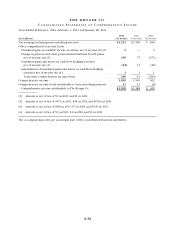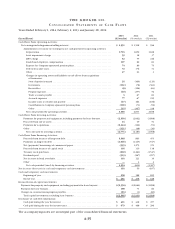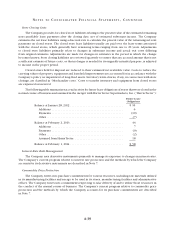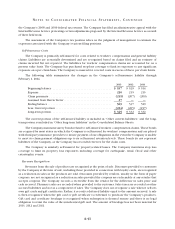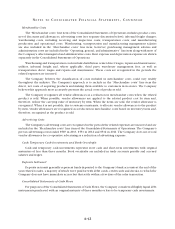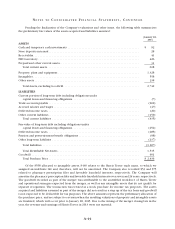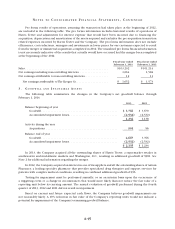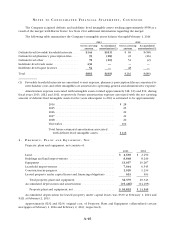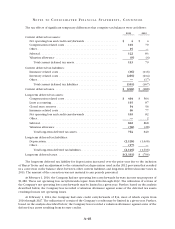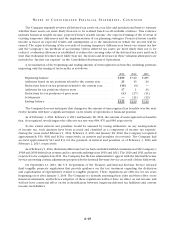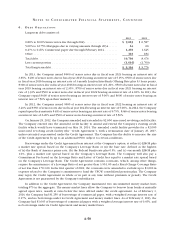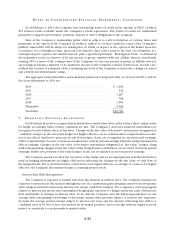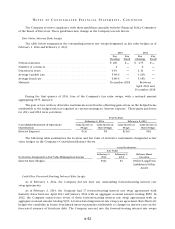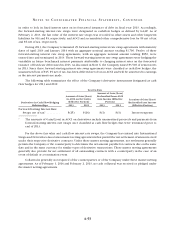Kroger 2013 Annual Report Download - page 116
Download and view the complete annual report
Please find page 116 of the 2013 Kroger annual report below. You can navigate through the pages in the report by either clicking on the pages listed below, or by using the keyword search tool below to find specific information within the annual report.
A-43
NO T E S T O C O N S O L I D A T E D F I N A N C I A L S T A T E M E N T S , CO N T I N U E D
Segments
The Company operates retail food and drug stores, multi-department stores, jewelry stores, and
convenience stores throughout the United States. The Company’s retail operations, which represent over
99% of the Company’s consolidated sales and EBITDA, are its only reportable segment. The Company’s retail
operating divisions have been aggregated into one reportable segment due to the operating divisions having
similar economic characteristics with similar long-term financial performance. In addition, the Company’s
operating divisions offer to its customers similar products, have similar distribution methods, operate in
similar regulatory environments, purchase the majority of the Company’s merchandise for retail sale from
similar (and in many cases identical) vendors on a coordinated basis from a centralized location, serve similar
types of customers, and are allocated capital from a centralized location. The Company’s operating divisions
reflect the manner in which the business is managed and how the Company’s Chief Executive Officer and
Chief Operating Officer, who act as the Company’s chief operating decision makers, assess performance
internally. All of the Company’s operations are domestic.
The following table presents sales revenue by type of product for 2013, 2012 and 2011.
2013 2012 2011
Amount % of total Amount % of total Amount % of total
Non Perishable (1) . . . . . . . . . . . . $49,229 50.0% $48,663 50.4% $46,494 51.5%
Perishable (2) . . . . . . . . . . . . . . . 20,625 21.0% 19,761 20.5% 18,588 20.6%
Fuel . . . . . . . . . . . . . . . . . . . . . . . 18,962 19.3% 18,896 19.5% 16,901 18.7%
Pharmacy . . . . . . . . . . . . . . . . . . 8,073 8.2% 8,018 8.3% 7,322 8.1%
Other (3) . . . . . . . . . . . . . . . . . . . 1,486 1.5% 1,281 1.3% 964 1.1%
Total Sales and other revenue . . . $98,375 100.0% $96,619 100.0% $90,269 100.0%
(1) Consists primarily of grocery, general merchandise, health and beauty care and natural foods.
(2) Consists primarily of produce, floral, meat, seafood, deli and bakery.
(3) Consists primarily of jewelry store sales, outside manufacturing sales and sales from entities not
controlled by the Company.
2 . M E R G E R
On January 28, 2014, the Company closed its merger with Harris Teeter by purchasing 100% of the
Harris Teeter outstanding common stock for $2,436. The merger allows us to expand into the fast-growing
southeastern and mid-Atlantic markets and into Washington, D.C. The merger was accounted for under the
purchase method of accounting and was financed through a combination of commercial paper and long-
term debt (see Note 6). In a business combination, the purchase price is allocated to assets acquired and
liabilities assumed based on their fair values, with any excess of purchase price over fair value recognized
as goodwill. In addition to recognizing the assets and liabilities on the acquired company’s balance sheet,
the Company reviews supply contracts, leases, financial instruments, employment agreements and other
significant agreements to identify potential assets or liabilities that require recognition in connection with
the application of acquisition accounting under ASC 805. Intangible assets are recognized apart from goodwill
when the asset arises from contractual or other legal rights, or are separable from the acquired entity such that
they may be sold, transferred, licensed, rented or exchanged either on a standalone basis or in combination
with a related contract, asset or liability.



